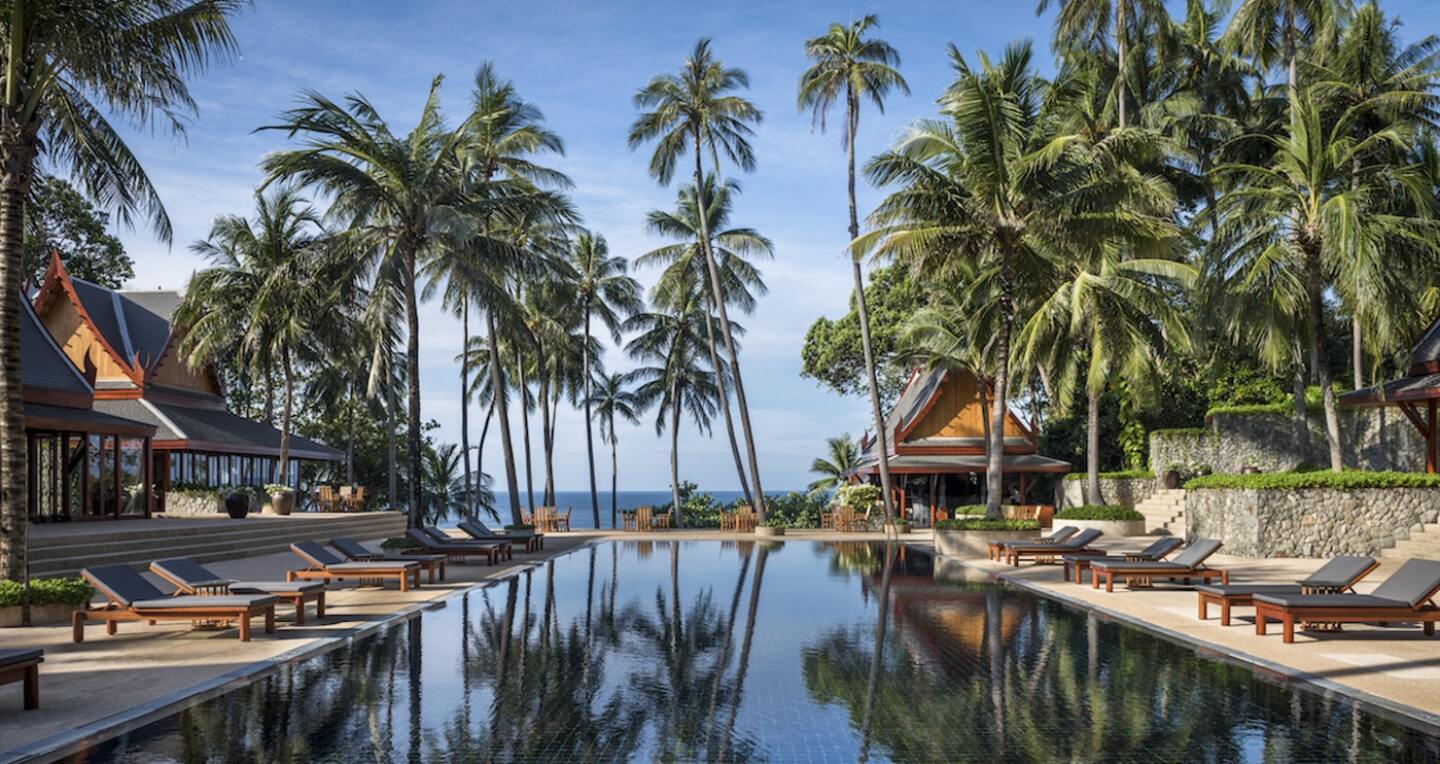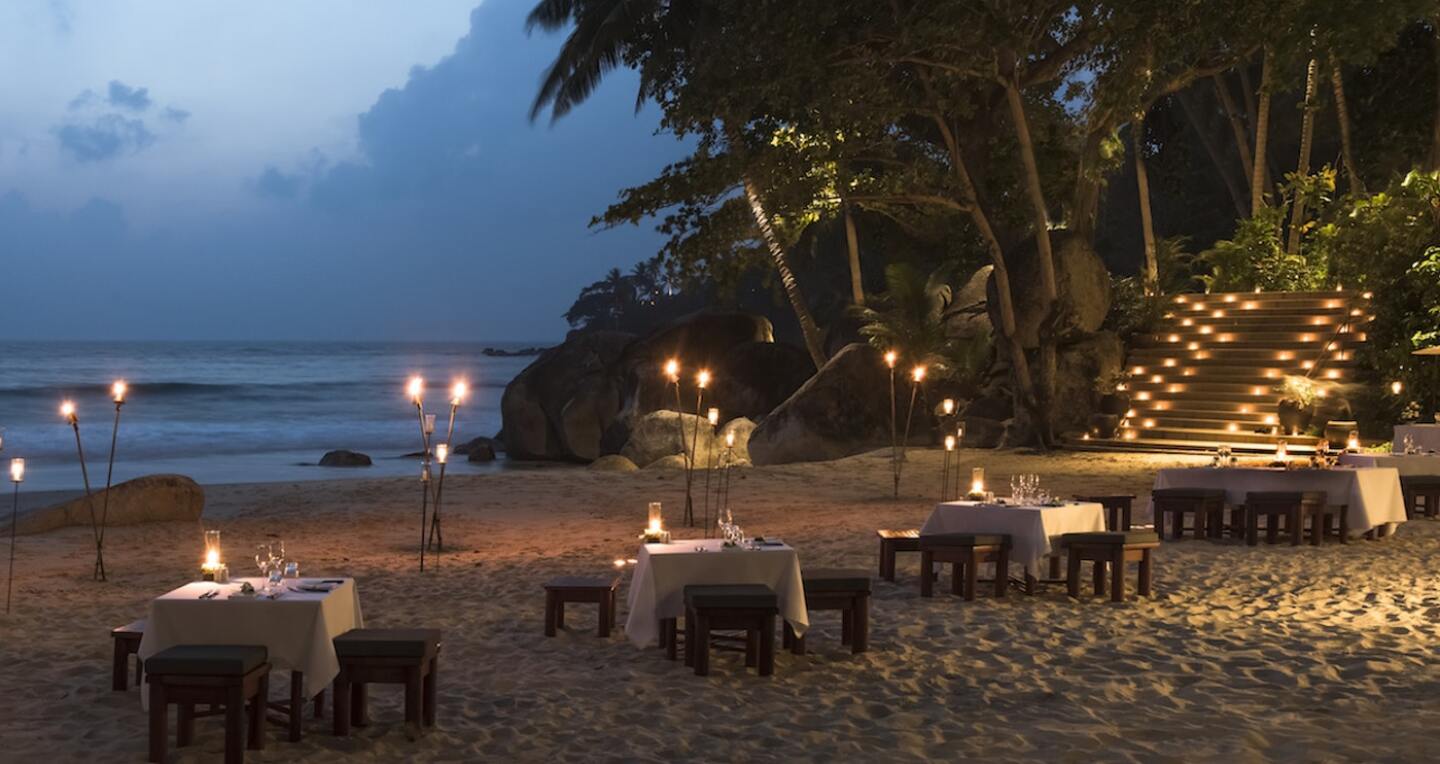A trip to Thailand can feel like three vacations in one, given the country’s remarkable diversity of landscapes and experiences. The itinerary that Michael Holtz of SmartFlyer has designed starts in Bangkok, a city that embodies both the dynamic energy and the rich culture of Thailand. In the space of a few hours, you may find yourself in a historic palace complex, visiting a traditional floating market, and sipping a cocktail in the newest luxury hotel.
In the north of Thailand, you’ll find a different world; in fact, much of it was historically a different country—the kingdom of Lanna. In Chiang Rai and Chiang Mai, the influences of nearby Myanmar and Laos have shaped the culture and cuisine, while the landscape consists of verdant mountains and rainforests.
Finally, the southern part of Thailand is where you’ll find the country’s famously stunning beaches. Here you can spend days snorkeling or simply swimming in the crystal-clear waters, cooling off with Thai-inspired cocktails, and refueling with meals of fresh seafood and spicy curries.
Everywhere you visit on this 12-day overview of Thailand, you’ll experience the gracious welcome for which the Land of Smiles is famous. It’s a similar reception to the one that will greet you when you board your Korean Air flight to begin your Thai odyssey. With 50 years’ experience bringing travelers to destinations across Asia, Korean Air will get you to Thailand and back in comfort and style.
Itinerary / 12 Days

DAY 1Fly to Bangkok

PHOTO BY MANDARIN ORIENTAL BANGKOK
DAY 2Arrive in Bangkok
After you’re settled, head out to start exploring the famous City of Angels. Your first stop is Yaowarat Road, in Bangkok’s Chinatown, which is lined with casual restaurants. You may want to stop at a few and try a variety of dishes: ba mee noodles, grilled squid, and ginger soup for dessert.
Traffic is often bad in Bangkok, so wave down a tuk-tuk, which can maneuver around the worst of it and visit the flower market, located just to the south of Wat Pho. The market serves up a dazzling floral display, with local flowers like orchids, lilies, and chrysanthemums, as well as imported delphiniums, snapdragons, and more. Then stop at nearby Wat Pho—the Temple of the Reclining Buddha—to see one of Bangkok’s most impressive sights, the 151-foot-long namesake Buddha gilded in gold.
After returning to the Mandarin Oriental for a rest, you’ll dine this evening at the Arun Residence, where the Deck restaurant overlooks the Chao Phraya River and (on the opposite bank) Wat Arun, with its Khmer-style tower illuminated at night.

PHOTO BY GREG NUNES
DAY 3Bangkok’s Grand Palace and the Canals of Thonburi
While this was the primary residence of the Thai kings until 1932, today it’s used only for ceremonial events and a few royal offices. A number of the buildings have now been converted to museums, including ones dedicated to textiles and coins. As much of the palace complex consists of temples, dress modestly—no shorts or sleeveless tops.
After your visit, head to lunch at the Supatra River House restaurant, located in a traditional Thai house on the banks of the Chao Phraya. The menu consists mostly of seafood dishes, from salmon satay to a variety of curries.
In the afternoon, you’ll explore the city by water, starting with the river that has been the main artery of commerce to and from the capital for centuries. Then explore the canals of Thonburi, the former capital of Bangkok located west of the river. While Bangkok is a spectacle of skyscrapers and activity, Thonburi offers a glimpse of a quieter side of Thailand, with merchants and farmers selling their goods at floating markets, and small temples where you may be the only travelers when you visit.
At the end of your cruise, stop at Wat Arun, the Temple of Dawn, for a closer look at the Khmer-style building you saw from a distance at dinner last night.

PHOTO BY FOUR SEASONS
DAY 4Travel to Chiang Rai
The city of Chiang Rai and the province of the same name lie far to the north of Thailand, near the Laos and Myanmar (formerly Burma) borders. In fact, this area didn’t become part of Thailand until the end of the 18th century. It was long part of the Lanna Kingdom, before later being incorporated into Burma for some 300 years.
Today, the city boasts a number of historic sites of note, including the famous White Temple. Still, compared to its better-known sister city, Chiang Mai, it’s a relatively quiet provincial town. After you land, you’ll be met by a driver who will take you roughly an hour north to Chiang Rai and one of Thailand’s most luxurious hotels, the Four Seasons Tented Camp Golden Triangle.
Yes, you’ll be staying in a tent, but you will definitely not be roughing it. Each tent has its own luxurious bed, as well as a full bath, with copper tub and outdoor rain shower. The tents’ décor varies, though all have hardwood floors and are furnished with safari-style handcrafted items made of dark woods and local textiles. Decks look out over the rainforest-filled Golden Triangle—the point where Myanmar, Laos, and Thailand meet.

PHOTO BY FOUR SEASONS
DAY 5Mahout Training
Later in the day, take advantage of the hotel’s spa—perhaps opting for the Mahout Recovery massage after your morning experiencing the life of a mahout. Poultices of camphor, lime, and lemongrass are used to get rid of knots and aches. The spa also offers a full menu of massages and face and body treatments, incorporating ingredients and techniques common to Burmese, Lao, or Thai wellness rituals.
After some time poolside, meet fellow guests and hotel staff at a wine and cheese tasting before dinner.

PHOTO BY FOUR SEASONS
DAY 6Cruise the Mekong
After lunch back at the Four Seasons, explore the rainforest on an afternoon hike. You’ll ascend to Camp Peak, the highest spot on the property, to take in the views of the Mekong River and the mountains of Laos on the other side. This being a Four Seasons, you can expect cold towels and water at exactly the moment you begin to feel warm; at the end of the walk, of course, the resort’s pools await. Another option is to join one of the foraging walks led by botanists, who point out all the edible herbs and other plants that grow in the wild here. You’ll learn about ingredients that fed the region’s residents for centuries and are now featured in dishes served by the camp’s restaurants.

PHOTO BY FOUR SEASONS
DAY 7Chiang Mai
The Four Seasons Chiang Mai sits amid rice fields roughly 40 minutes from the city, with rooms in pavilions located throughout the grounds. Book one of the Rice Pavilion Suites to take in the views from the daybed on your spacious outdoor sala, or terrace; or stay in one of the Garden Pavilions, set amid the tropical landscaped grounds.
After you’ve settled into your room and taken a dip in the infinity pool above the rice fields, head into Chiang Mai for a motor scooter tour, followed by a Northern Thai dinner. The night markets of Chiang Mai are one of the city’s main attractions and a favorite of serious shoppers. You can find everything from produce and T-shirts to high-quality crafts. There are more than a dozen different markets, each with its own specialty and atmosphere.

PHOTO BY FOUR SEASONS
DAY 8Cooking School
In the afternoon, visit the nearby 6,500-acre Queen Sikrit Botanic Garden, which includes 12 greenhouses. While its collection of plants is encyclopedic, its most interesting collections focus on the plants common to northern Thailand—cycads, palms, bananas, ginger, and other tropical species—and has become a vital resource for botanists around the world. Don’t miss the nature trail to the Mae Sa Noi Waterfall, lined with verbenas, mulberry, and other indigenous plants.
Afterwards, return to the Four Seasons for dinner at Khao, where the menu includes not only Thai dishes but specialties of Myanmar and Yunnan as well.

PHOTO BY AMAN
DAY 9Travel to Phuket
Having experienced the excitement of Thailand’s capital and some of the cultural and natural highlights of the country’s north, you’ll spend the final days of your trip experiencing island living, Thai style. The country has, by some counts, more than 1,400 islands along its Andaman Sea and Gulf of Thailand coasts. Phuket, however, stands out from many of the others with its lush interior and beautiful beaches.
Your home on Phuket will be Amanpuri, the first Aman resort and one that helped set the standard for all that followed. Located on a private peninsula on the island’s west coast, the resort’s 40 pavilions celebrate Thai style, from their distinctive rooflines to the orchids and silk pillows. Many have private pools, and all have salas—open-air decks—with daybeds. Spend the rest of this day lounging poolside or on the resort’s Pansea Beach.

PHOTO BY AMAN
DAY 10Phuket
Then head back to Amanpuri, where you can spend the afternoon trying some of the activities at the water sports center—stand-up paddleboarding, kayaking, or one of the newest crazes, flyboarding. If you’d rather take it easy and doze off to the sound of ocean breezes rustling the coconut palms that dot the resort, do it—after all, it’s your vacation.

PHOTO BY AMAN
DAY 11Spa Day
Start your morning here with a daybreak yoga and meditation session before breakfast at the resort. When you return later for a treatment, you’ll get to enjoy the amenities of the recently renovated and expanded spa. New relaxation areas for before or after spa treatments include saunas, Jacuzzis, and cold plunge pools. The result is that the spa and wellness center have become destinations where you may want to spend much of your day.
You can venture out of the resort to check a few more items off your list of sights, like the Big Buddha—a 150-foot-tall statue that is Phuket’s most famous landmark. Or you may want to simply enjoy some of Amanpuri’s other services and amenities, like a cooking class or tennis lesson.
For your final dinner in Thailand, sample typical southern Thai dishes (and compare them to northern Thai cuisine) at the resort’s simply named Thai Restaurant. (You can also choose from Italian and Japanese options.)

DAY 12Departure
After exploring the best of Thailand, including some of the most luxurious hotels in all of Asia, it would be natural to feel a bit of a letdown to have reached the end of your adventure. But if you’re flying in First Class and Prestige Class on Korean Air, the return to everyday life can wait a little while longer as you enjoy some final luxurious touches, like the Atelier Cologne amenity kits, gourmet “farm-to-flight” meals, and the chic Celestial Bar—a cocktail lounge high in the sky that you’ll find on the A380 overseas flight.






